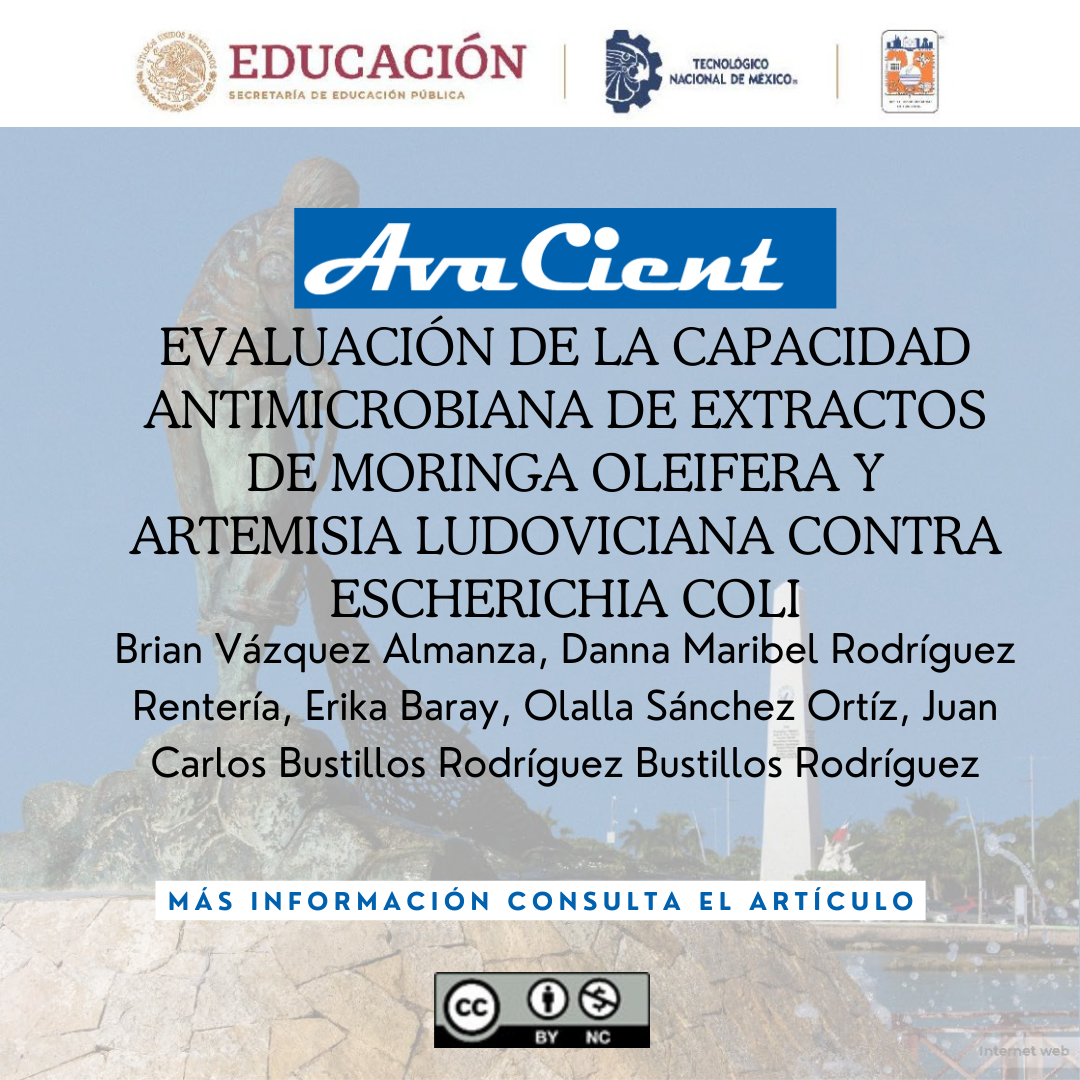EVALUACIÓN DE LA CAPACIDAD ANTIMICROBIANA DE EXTRACTOS DE MORINGA OLEIFERA Y ARTEMISIA LUDOVICIANA CONTRA ESCHERICHIA COLI
DOI:
https://doi.org/10.69823/avacient.v3n1a3Palabras clave:
Alimentos, ETAS, inocuidad, natural, preservaciónResumen
La alimentación es fundamental para la vida y el desarrollo de la población a nivel mundial, por lo que la seguridad alimentaria es un derecho humano básico. La cantidad de brotes de enfermedades transmitidas por alimentos asociados con productos frescos ha ido en aumento, por lo que es necesario buscar estrategias que aseguren que los alimentos que consumimos se encuentran libre de patógenos. Dado lo anterior, el objetivo del presente estudio fue la obtención de extractos de plantas de Moringa oleifera y Artemisia ludoviciana y evaluar la capacidad antimicrobiana in vitro de dichos extractos contra E. coli. Para lo cual, se obtuvo un aislado de E. coli a partir de carne molida de res, así como extractos vegetales de M. oleifera y A. ludoviciana utilizando alcohol etílico 96°, a dichos extractos se les evaluó la capacidad antimicrobiana hacia E. coli, a través de la medición de los halos de inhibición. A partir de las 24 h post inoculación fue posible observar la presencia de inhibición del crecimiento de la bacteria, especialmente con el extracto de la semilla de M. oleifera al presentar un diámetro de inhibición mayor a comparación de los demás extractos, teniendo un promedio de 13.5 mm, seguido de la hoja de A. ludoviciana 8.8 mm y la hoja de M. oleifera con un promedio de 7.8 mm. Por lo que, dichos resultados contribuyen a respaldar la capacidad antimicrobiana de estas plantas, además de sugerir la elaboración de posibles productos antimicrobianos que permitan ampliar su aplicación y comercialización en el manejo y prevención de enfermedades causadas por patógenos.
Descargas
Citas
Abadallah, M.S., Ali, M. (2019). Antibacterial activity of Moringa oleifera leaf extracts against bacteria isolated from patients attending general Sani Abacha Specialist Hospital Damaturu. Journal of Allied Pharmaceutical Sciences. 1(1): 61-66. https://www.researchgate.net/profile/Muhammad-Salihu-Abdallah-2/publication/332013718
Abebe, E., Gugsa, G., y Ahmed, M. (2020). Review on major food-borne zoonotic bacterial pathogens. Journal of Tropical Medicine, 2020. https://doi.org/10.1155/2020/4674235
Barani, M., Zeeshan, M., Kalantar-Neyestanaki, D., Farooq, M. A., Rahdar, A., Jha, N. K., y Thakur, V. K. (2021). Nanomaterials in the management of gram-negative bacterial infections. Nanomaterials, 11(10), 2535. https://doi.org/10.3390/nano11102535
Barlaam, A., Parisi, A., Spinelli, E., Caruso, M., Taranto, P. D., y Normanno, G. (2019). Global emergence of colistin- resistant Escherichia coli in food chains and associated food safety implications: A review. Journal of Food Protection, 82(8), 1440-1448. https://doi.org/10.4315/0362-028X.JFP-19-116
Bhalla, N., Ingle, N., Jayaprakash, A., Patel, H., Patri, S. V., y Haranath, D. (2022). Green Approach to Synthesize Nano Zinc Oxide via Moringa oleifera Leaves for Enhanced Anti-oxidant, Anti-acne and Anti-bacterial Properties for Health & Wellness Applications. Arabian Journal of Chemistry, 104506. https://doi.org/10.1016/j.arabjc.2022.104506
Bisht, D., Kumar, D., Kumar, D., Dua, K., y Chellappan, D. K. (2021). Phytochemistry and pharmacological activity of the genus artemisia. Archives of Pharmacal Research, 44(5), 439-474. https://doi.org/10.1007/s12272-021- 01328-4
Chebbac, K., Moussaoui, A. E., Bourhia, M., Salamatullah, A. M., Alzahrani, A., y Guemmouh, R. (2021). Chemical analysis and antioxidant and antimicrobial activity of essential oils from Artemisia negrei L. Against drug-resistant microbes. Evidence-Based Complementary and Alternative Medicine. https://doi.org/10.1155/2021/5902851
Cole, M. B., Augustin, M. A., Robertson, M. J., y Manners, J. M. (2018). The science of food security. npj Science of Food, 2(1), 1-8. https://doi.org/10.1038/s41538-018-0021-9
Delgadillo-Ruíz, L., Bañuelos-Valenzuela, R., Delgadillo-Ruíz, O., Silva-Vega, M., Gallegos-Flores, P. (2017). Composición química y efecto antibacteriano in vitro de extractos de Larrea tridentata, Origanum vulgare, Artemisa ludoviciana y Ruta graveolens. Nova Scientia. 9(19): p. 273-290. https://doi.org/10.21640/ns.v9i19.1019
Ekiert, H., Pajor, J., Klin, P., Rzepiela, A., Ślesak, H., y Szopa, A. (2020). Significance of Artemisia vulgaris L.(Common Mugwort) in the history of medicine and its possible contemporary applications substantiated by phytochemical and pharmacological studies. Molecules, 25(19), 4415. https://doi:10.3390/molecules25194415
Eltai, N.O., Yassine, H.M., Al Thani, A.A., Abu Maid, M.A., Ismail, A., Ibrahim, E., Alali, W.Q. (2018) Prevalence of antibiotic resistant Escherichia coli isolates from fecal samples of food handlers in Qatar. Antimicrobial Resistance & Infection Control. 7(1): p. 1-7. https://doi.org/10.1186/s13756-018-0369-2
FadiaTaufik, M., Rashed, A., Oshkondali, S. T., Alacrouk, S. A., y Sleman, K. (2021). Antibacterial activities of Moringa oleifera leaf extract on some human pathogenic bacteria. Saudi Journal of Medical and Pharmaceutical Sciences, 7, 426-431. https://doi: 10.36348/sjmps.2021.v07i08.009
Fernández, S., Marcía, J., Bu, J., Baca, Y., Chávez, V., Montoya, H., Varela, I., Ruiz, J., Lagos, S., Ore, F. (2021). Enfermedades transmitidas por Alimentos (Etas): Una Alerta para el Consumidor. Ciencia Latina Revista Científica Multidisciplinar. 5(2): p. 2285. https://ciencialatina.org/index.php/cienciala/article/download/433/542
Fung, F., Wang, H.-S., y Menon, S. (2018). Food safety in the 21st century. Biomedical Journal. 41(2): p. 88-95. https://doi.org/10.1016/j.bj.2018.03.003
Gálvez-Romero, J. L., Parada-Sosa, C. M., León-Burgoa, G., Lorenzo-Leal, A. C., El Kassis, E. G., Bautista- Rodríguez, E., Paredes-Juárez, G.A., Hernández, L.R., Bach, H., y Juárez, Z. N. (2022). Antimycobacterial, cytotoxic, and anti-inflammatory activities of Artemisia ludoviciana. Journal of Ethnopharmacology, 293, 115249. https://doi.org/10.1016/j.jep.2022.115249
Kılıç, A.B., Altınkaynak, C., Ildiz, N., Ozdemir, N., Yilmaz, V., y Ocsoy, I. (2020). A new approach for green synthesis and characterization of Artemisia l. .(Asteraceae) genotype extracts-Cu2 nanocomplexes (nanoflower) and their effective antimicrobial activity. Medicine Science International Medical Journal. 9(191-196). https://doi:10.5455/medscience.2019.08.9165
Luna-Guevara, J.J., Arenas-Hernandez, M.M., Martínez de la Peña, C., Silva, J.L., Luna-Guevara, M.L. (2019). The role of pathogenic E. coli in fresh vegetables: Behavior, contamination factors, and preventive measures. International Journal of Microbiology. https://doi.org/10.1155/2019/2894328
Manandhar, S., Luitel, S., Dahal, R.K. (2019). In vitro antimicrobial activity of some medicinal plants against human pathogenic bacteria. Journal of Tropical Medicine. https://doi.org/10.1155/2019/1895340
Martins, S., Teixeira, J.A., Mussatto, S.I. (2013). Solid-state fermentation as a strategy to improve the bioactive compounds recovery from Larrea tridentata leaves. Applied Biochemistry and Biotechnology. 171(5): p. 1227- 1239. https://doi.org/10.1007/s12010-013-0222-2
Mirsepasi-Lauridsen, H.C., Vallance, B.A., Krogfelt, K.A., Petersen, A.M. (2019). Escherichia coli pathobionts associated with inflammatory bowel disease. Clinical Microbiology Reviews. 32(2): p. e00060-18. https://doi:10.1128/CMR.00060-18
Mohammed, S., Dekabo, A., y Hailu, T. (2022). Phytochemical analysis and anti-microbial activities of Artemisia spp. and rapid isolation methods of artemisinin. AMB Express, 12(1), 1-15. https://doi.org/10.1186/s13568-022-01346- 5
Montero-Recalde, M.A., Martinez-Jimenéz, J.A., Avilés-Esquivel, D.F., Valle-Velástegui, E.L., Pazmiño-Miranda, N.D.P. (2017). Efecto antimicrobiano del extracto crudo oleoso de Rosmarinus officinalis sobre cepa de Escherichia coli. Journal of the Selva Andina Biosphere. 5(2): p. 168-175. http://www.scielo.org.bo/scielo.php?script=sci_arttext&pid=S2308-38592017000200012&lng=es.
Nigam, M., Atanassova, M., Mishra, A. P., Pezzani, R., Devkota, H. P., Plygun, S., y Sharifi-Rad, J. (2019). Bioactive compounds and health benefits of Artemisia species. Natural product communications, 14(7), 1934578X19850354. https://doi:10.1177/1934578X19850354
Nurafifah, D. A., Widyastuti, D. A., y Minarti, I. B. (2021). Activity of Moringa oleifera seed ethanolic extract against E. coli. Advance Sustainable Science, Engineering and Technology (ASSET), 3(2), 0210207. https://doi.org/10.26877/asset.v3i2.9603
OMS, Organización Mundial de la Salud (2014). Antimicrobial resistance: global report on surveillance.
Oviedo-Farfan, K.T., Escobar-Bello M.L. (2020). Propuesta para la elaboración de un gel antibacterial con base en las hojas de Moringa oleifera Lam. (Moringaceae) cultivada en Colombia, en Facultad de Ingenierías. Fundación Universidad de América: Colombia. p. 165.
Oyebamiji, A. K., Folorunso, A. S., y Akintelu, S. A. (2021). Phytochemical and antibacterial investigation of Moringa oleifera seed: experimental and computational approaches. Eclética Química, 46(2), 17-25. https://doi.org/10.26850/1678-4618eqj.v46.2.2021.p17-25
Özcan, M. (2020). Moringa spp: Composition and bioactive properties. South African Journal of Botany. 129: p. 25- 31. https://doi.org/10.1016/j.sajb.2018.11.017
Palacios-Espinosa, J.F., Núñez-Aragón, P.N., Gomez-Chang, E., Linares, E., Bye, R., Romero, L. (2021). Anti- Helicobacter pylori activity of Artemisia ludoviciana subsp. mexicana and two of its bioactive components, estafiatin and eupatilin. Molecules. 26(12): p. 3654. https://doi.org/10.3390/molecules26123654
Rahman, M., Alam, M. U., Luies, S. K., Kamal, A., Ferdous, S., Lin, A., Shairor, F., Khan,R., Rahman, Z., Parvez, S.M., Amin, N., Hasan, R.,Tadesse, B.T., Taneja, N., Islam, M.A., y Ercumen, A. (2022). Contamination of fresh produce with antibiotic-resistant bacteria and associated risks to human health: a scoping review. International journal of environmental research and public health, 19(1), 360. https://doi.org/10.3390/ijerph19010360
Rohr, J. R., Barrett, C. B., Civitello, D. J., Craft, M. E., Delius, B., DeLeo, G. A., y Tilman, D. (2019). Emerging human infectious diseases and the links to global food production. Nature sustainability, 2(6), 445-456. https://doi.org/10.1038/s41893-019-0293-3
Salem, M.Z., Ali, H.M., Akrami, M. (2021). Moringa oleifera seeds-removed ripened pods as alternative for papersheet production: Antimicrobial activity and their phytoconstituents profile using HPLC. Scientific Reports. 11(1): p. 1-13. https://doi.org/10.1038/s41598-021-98415-9
Sharma, P., Wichaphon, J., y Klangpetch, W. (2020). Antimicrobial and antioxidant activities of defatted Moringa oleifera seed meal extract obtained by ultrasound-assisted extraction and application as a natural antimicrobial coating for raw chicken sausages. International Journal of Food Microbiology, 332, 108770. https://doi.org/10.1016/j.ijfoodmicro.2020.108770
Smith, B. E., Orders, T., Slate, J., Bauldry, S., Emrani, J., Idassi, J., Ahmed, M., Cecile, J., Bailey, C.S., Nguyen, N.A., y Mowa, C. (2020). Proteomics analysis reveal that Moringa oleifera kills Escherichia coli by altering multiple biological processes. South African Journal of Botany, 129, 366-378. https://doi.org/10.1016/j.sajb.2019.08.056
Tessema, A.G., Gelaye, K.A., Chercos, D.H. (2014). Factors affecting food handling Practices among food handlers of Dangila town food and drink establishments, North West Ethiopia. BMC Public Health. 14(1): p. 1-5. https://doi.org/10.1186/1471-2458-14-571
Tshabalala, T., Ndhlala, A. R., Ncube, B., Abdelgadir, H. A., y Van Staden, J. (2020). Potential substitution of the root with the leaf in the use of Moringa oleifera for antimicrobial, antidiabetic and antioxidant properties. South African Journal of Botany, 129, 106-112. https://doi.org/10.1016/j.sajb.2019.01.029
Unegbu, V., Nkwoemeka, N., Okey-Ndeche, F., Obum-Nnadi, C. (2020). Phytochemical and Antibacterial Properties of Moringa oleifera leaf extracts on Escherichia coli and Staphylococcus aureus. Nigerian Journal of Microbiology. 34(1): p. 5145-5152 https://www.researchgate.net/profile/Ndidi- Nkwoemeka/publication/343084196
Wang, X., He, L., Huang, Z., Zhao, Q., Fan, J., Tian, Y., y Huang, A. (2023). Isolation, identification and characterization of a novel antimicrobial peptide from Moringa oleifera seeds based on affinity adsorption. Food Chemistry, 398, 133923. https://doi.org/10.1016/j.foodchem.2022.133923
Zazharskyi, V., Davydenko, P., Kulishenko, O., Borovik, I.V., Brygadyrenko, V.V. (2019). Antimicrobial activity of 50 plant extracts. Biosystems Diversity. 27(2): p. 163-169. https://doi: 10.15421/011922

Descargas
Publicado
Cómo citar
Número
Sección
Licencia
Derechos de autor 2024 AvaCient

Esta obra está bajo una licencia internacional Creative Commons Atribución-NoComercial 4.0.











